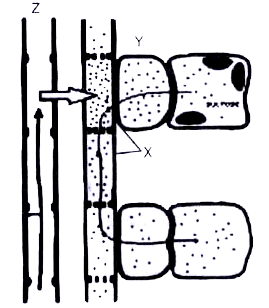Case 2: Plants use relatively slow transport system as they have low energy needs. The distances over which transport systems have to operate, however, can be very large in plants such as very tall tress, Plant transport systems move energy stores from leaves and raw materials from roots.
The given figure represents the movement of water and minerals is xylem and movement of food in phloem.

Choose the correct combination of plots provided in the following table.
XYZMajor conducting cells in xylemDenucleated Flow is bidirectional
XYZMajor conducting cells in phloemNucleated Flow is unidirectional
XYZMajor conducting cells in xylem and phloemDenucleated Flow is unidirectional
XYZcells in xylem but function is not definedNucleated Flow is bidirectional
The correct Answer is:B
In the given figure, X represents the sieve tube elements, Y represents the companion cell and Z represents the Xylem. Sieve tube elements are the major conducting cells of phloem tissues. Companion cell is usually closely associated with a sieve element and it is nucleated though sieve tube elements don.t possess nucleus.
Related Theory
The transport of water in the xylem takes place only from the roots to the leaves. Therefore the movement of water and nutrients in the xylem is unidirectional.
Related Playlists
Similar Questions
The plant transport systems will mobilize energy stores, food from and raw materials from __________
View SolutionGive reasons
Transport system in plants is slow.View SolutionThe following transport water and minerals in a plant
View SolutionExplain how water and minerals are transported in plants?
View SolutionHow are water and mineral transported in plants?
View SolutionHow are water and minerals transported in plants ?
View SolutionHow are water and minerals transported in plants?
View SolutionHow are water and minerals transported in plants?
View SolutionHow are water and minerals transported in plants?
View SolutionHow are water and minerals transported in plants?
View Solution

